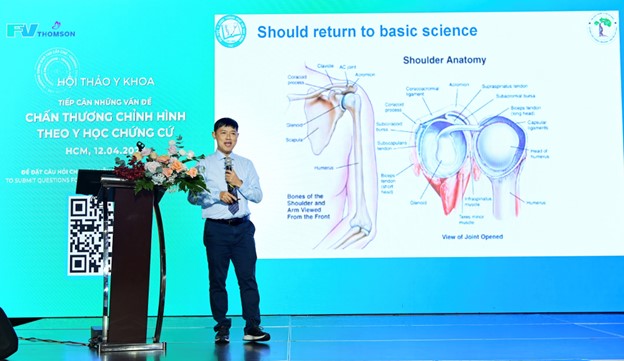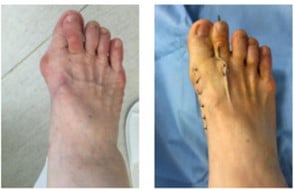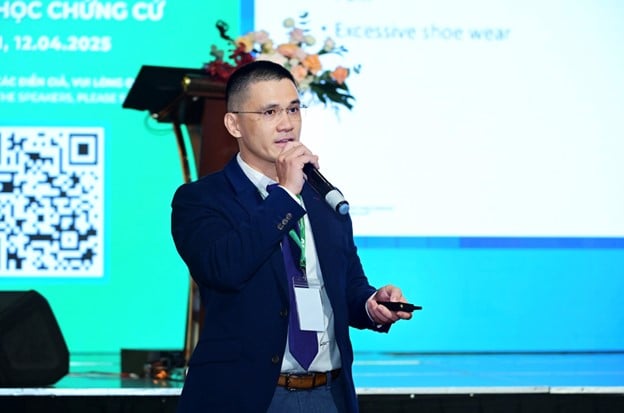To begin, the chairman of the workshop, Associate Professor, Doctor Do Phuoc Hung, Head of the Department of Orthopedics and Rehabilitation, University of Medicine and Pharmacy of Ho Chi Minh City, presented the topic "First-time shoulder dislocation - Conservative treatment or surgery?". This is a common injury, especially among athletes . When a shoulder dislocation occurs, the patient will have the joint realigned; however, the question arises: what should be done next, should surgical or conservative treatment be pursued to prevent recurrence?

Associate Professor, Doctor Do Phuoc Hung, Head of the Department of Orthopedics and Rehabilitation, Ho Chi Minh City University of Medicine and Pharmacy, shared at the conference.
Photo: TQ
According to Dr. Hung, about 50% of patients treated conservatively do not experience re-dislocation, so not everyone who dislocates for the first time needs surgery. The advantage of surgery (mainly Bankart arthroscopic surgery) is that it reduces the rate of re-dislocation (10% compared to 55% without surgery), mainly helping athletes return to competition sooner. However, it can also cause complications in some patients. Based on clinical experience, doctors can determine whether surgery is necessary for a patient based on several factors: age (younger people have a higher risk of re-dislocation), the extent of bone damage, athletic needs, and clinical examination results.
Big toe deviation: A common condition that has not received adequate attention.
In his presentation, Dr. Le Trong Phat, Head of the Department of Orthopedics and Hand Surgery at FV Hospital, mentioned bunions – a deformity caused by the joint at the base of the big toe developing to one side, resulting in the big toe bone tilting towards the smaller toe. Up to 23% of adults aged 18-65 suffer from this condition. Women have a 2-3 times higher incidence than men, with one of the identified causes being the frequent use of high heels. However, this condition has not received adequate attention.

Before and after surgery for bunion at FV Hospital
Photo: BVCC
To treat bunions, mild cases may require changing footwear, using pads, toe separators, or orthopedic splints. Severe cases may require surgery. "The goal of surgery is to correct the bone and soft tissues (tendons, muscles). If only the bone is corrected without addressing the soft tissues, the risk of failure can be as high as 90%," Dr. Phat explained.
Misconceptions about flat feet in children
Another issue related to the feet is flexible flat feet, which was presented at the conference by Dr. Truong Hoang Vinh Khiem, Specialist in Orthopedics and Hand Surgery, FV Hospital. Recently, many parents have been taking their children for screening and treatment of flat feet at a very young age. However, according to Dr. Khiem, early treatment is unnecessary. A study showed that nearly 94-100% of 2-year-old children have flat feet, but by the age of 10, this rate drops to only 4%. This indicates that most children will develop a normal arch as they grow older.
Treatment for symptomatic flat feet in children should begin between the ages of 8 and 13, such as encouraging barefoot walking to strengthen the structures, muscles, and ligaments; wearing insoles to create an arch; and in severe cases (children complain of foot pain at night, have an awkward gait, are prone to tripping, etc.), surgery may be necessary.

Specialist Doctor Truong Hoang Vinh Khiem presents issues related to flat feet.
Photo: TQ
Complete cure for rheumatoid arthritis in the near future.
This refers to the treatment of rheumatoid arthritis (also known as rheumatism). This is a chronic inflammatory joint disease that affects the synovial membrane, destroys cartilage and bone, and can lead to disability. Approximately 1-2% of the population suffers from this disease.
Dr. Nguyen Chau Tuan, a specialist in Internal Medicine and Musculoskeletal Disorders at the University Medical Center of Ho Chi Minh City, advises patients to seek early diagnosis and treatment. There are many causes of polyarthritis, therefore individualized treatment is crucial. Patients may receive a combination of medication, physical therapy, and surgery may be necessary in cases of joint deformities. "The ultimate goal of treating rheumatoid arthritis is to reverse the disease, prevent complications, and preserve the patient's quality of life," Dr. Tuan emphasized.
Source: https://thanhnien.vn/dot-pha-moi-trong-dieu-tri-chan-thuong-chinh-hinh-185250415210440133.htm



![[Photo] General Secretary To Lam visits the exhibition space showcasing books, photo exhibitions, and achievements of digital transformation in journalism.](/_next/image?url=https%3A%2F%2Fvphoto.vietnam.vn%2Fthumb%2F1200x675%2Fvietnam%2Fresource%2FIMAGE%2F2025%2F12%2F19%2F1766110879215_1766110240024-jpg.webp&w=3840&q=75)



![[Photo] Enchanting ancient rose garden on the mountainside in Nghe An](/_next/image?url=https%3A%2F%2Fvphoto.vietnam.vn%2Fthumb%2F1200x675%2Fvietnam%2Fresource%2FIMAGE%2F2025%2F12%2F19%2F1766109900916_vuon-hong-chin-do-thu-hut-du-khach-toi-check-in-o-ha-noi-3-20162778-1671624890024-1671624890104198100259.jpeg&w=3840&q=75)
































































































Comment (0)